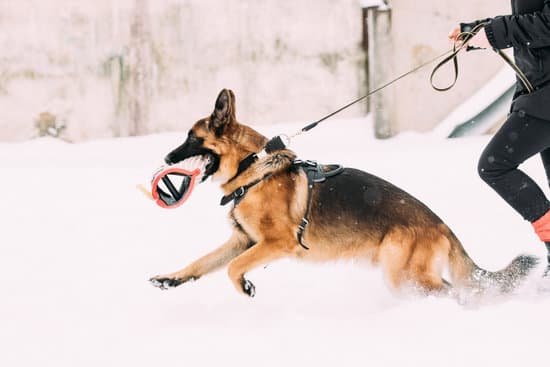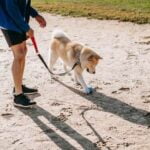As expecting or new parents, one of the most important considerations is how to ensure a harmonious and safe relationship between your dog and your baby. Baby training for dogs is a crucial step in this process, as it helps in establishing boundaries, promoting positive behavior, and creating a nurturing environment for both the dog and the baby. By introducing proper training techniques, you can lay the foundation for a strong bond between your furry friend and your little one.
Baby training for dogs goes beyond just teaching them basic commands; it involves preparing them to adjust to the arrival of a new family member while maintaining their happiness and well-being. This not only provides peace of mind for parents, but it also creates an environment where your dog feels secure and comfortable with the new addition to the family.
In this article, we will guide you through essential steps to take in preparing your dog for the arrival of your baby. We will explore various techniques such as positive reinforcement and reward-based training methods that can be used to train both dogs and babies alike.
Additionally, we will address common challenges that may arise during this process and offer troubleshooting tips to overcome them. By following these guidelines, you can shape a lifelong friendship between your dog and baby, ensuring joyous interactions and a strong bond that will last throughout their lives together.
The Benefits of Baby Training for Dogs
Training your dog to coexist safely and happily with a new baby is an essential step for both the dog’s well-being and the overall harmony of your household. By preparing your dog for the arrival of a baby and implementing proper training techniques, you can create a safe and happy environment for everyone involved.
Reduced Stress Levels
Baby training for dogs helps to reduce stress levels for both the dog and the baby. Dogs thrive on routine and structure, so introducing them to various baby-related scenarios prior to the arrival can help minimize anxiety.
By slowly acclimating your dog to the sight, sound, and smell of babies through simulated experiences, such as using play dolls or playing recordings of baby sounds, you are setting them up for success. This gradual introduction can help reassure your dog that babies are not a threat, ultimately reducing any potential stress levels.
Better Behavior
Proper training ensures that your dog behaves appropriately around the baby. The foundation of this behavior starts with reinforcing basic commands like sit, stay, leave it, and down. Teaching these commands early on will allow you to redirect or control your dog’s behavior when needed, preventing any unwanted interactions between them and the baby. Consistency is key when it comes to training – establishing clear boundaries will help foster good behavior in your furry companion.
A Bond That Lasts a Lifetime
By engaging in baby training with your dog, you have an opportunity to strengthen the bond between them and ensure a lasting friendship. Encourage positive interactions between your pet and baby by praising gentle behaviors with rewards or affection. Allow supervised playtime sessions where both parties can interact under close observation. As they spend more time together in a controlled environment, their bond will develop naturally over time.
Preparing Your Dog for the Arrival of the Baby
Preparing your dog for the arrival of a new baby is an essential part of baby training. It is important to take certain steps to ensure that your dog is well-adjusted and ready for this significant change in their environment. By following these essential steps, you can help create a smooth transition for both your dog and your baby.
The first step in preparing your dog for the arrival of the baby is to establish a routine. Dogs thrive on consistency, so it is important to maintain a regular schedule to help them feel secure. This includes regular feeding times, exercise routines, and play sessions. By maintaining a consistent routine, your dog will have an easier time adjusting when the baby arrives.
Another important step is to introduce your dog to new sounds and scents that they may encounter when the baby arrives. For example, you can play recordings of baby cries or use lotions and powders with baby scents on yourself to familiarize your dog with these new smells. This will help prevent any fear or anxiety when the actual sounds and smells are present.
It is also crucial to gradually decrease attention given to your dog before the arrival of the baby. This helps prevent any feelings of jealousy or resentment towards the new family member. You can start by reducing spoiling behaviors such as constant petting or cuddling, and instead focus on reinforcing calm behavior through rewards.
Taking these essential steps will lay a strong foundation for introducing your dog to their new role in the family. By establishing routines, familiarizing them with new sounds and scents, and gradually decreasing attention, you can help mitigate any potential challenges that may arise during this transformative time.
| Essential Steps | Benefits |
|---|---|
| Establishing a routine | Creates a sense of security and stability for the dog |
| Introducing new sounds and scents | Prevents fear or anxiety in the presence of the baby |
| Gradually decreasing attention | Prevents jealousy or resentment towards the baby |
Building a Strong Foundation
Introducing basic commands and behavior guidelines is essential in building a strong foundation for baby training a dog. These commands not only help establish boundaries and expectations, but they also promote good behavior and ensure the safety of both the dog and the baby. By teaching your dog these basic commands, you can create a harmonious environment where your furry friend understands what is expected of them.
One of the most fundamental commands to introduce is “sit.” Teaching your dog to sit on command can be very useful in various situations, especially when interacting with the baby. It helps prevent jumping up, which can potentially pose a danger to the baby. To teach this command, start by holding a treat close to your dog’s nose and moving it upward.
As their head follows the treat, their bottom should naturally lower into a sitting position. Once they are seated, reward them with praise or a treat. With consistent practice and reinforcement, your dog will learn to associate this command with sitting.
Another important command to teach is “stay.” This command can be especially useful when you need your dog to stay in one place while you attend to the baby or when you want them to keep their distance from certain areas or objects that could be harmful. Begin by asking your dog to sit.
Then, with an open palm facing towards them, step back slowly while saying “stay” firmly. If they remain seated without moving for a few seconds, reward them with praise or a treat. Gradually increase the duration of time they need to stay before receiving their reward.
In addition to these basic commands, it’s crucial to establish behavior guidelines for your dog around the baby. For example, discourage any rough play or jumping on furniture that could potentially harm or startle the baby. Teach your dog appropriate behaviors such as gentle interaction and staying calm around the baby. Consistency is key when implementing these guidelines.
By introducing basic commands like sit and stay and setting proper behavior guidelines, you are building a strong foundation for your dog’s training. These commands and guidelines will help your dog understand their role in the family and ensure a safe environment for both the dog and the baby. Remember to be patient and consistent in your training efforts, and before long, you’ll have a well-behaved dog who is ready to coexist peacefully with your little one.
Positive Reinforcement Techniques
When it comes to training dogs to interact safely and positively with babies, using positive reinforcement techniques is key. Reward-based training methods not only help in teaching dogs appropriate behaviors around babies but also contribute to creating a strong and positive bond between the dog and the baby. This section will explore some effective positive reinforcement techniques that can be used for both dogs and babies during training.
Clicker Training
One popular positive reinforcement technique is clicker training. This method involves using a small handheld device called a clicker that makes a distinct clicking sound when pressed. The purpose of the clicker is to mark the precise moment when the dog or baby exhibits a desired behavior.
This helps in reinforcing that particular behavior and associating it with a reward. For example, if your dog sits calmly while your baby plays nearby, you can use the clicker to mark that behavior and then immediately give your dog praise or a treat as a reward.
Treat Rewards
Treat rewards are another effective positive reinforcement technique that can be used during baby training for both dogs and babies. Using small, tasty treats as rewards helps in motivating dogs to learn new behaviors that are desired around the baby.
For example, when your baby is playing on the floor, you can give your dog treats for calm behavior such as sitting or lying down at a distance from the baby. Similarly, you can encourage gentle interaction between your dog and baby by rewarding both of them when they engage in appropriate interactions such as sniffing each other gently or sharing toys.
Praise and Affection
In addition to treats, verbal praise and affection are powerful tools for reinforcing positive behaviors in both dogs and babies. Dogs thrive on praise from their owners, so be sure to use verbal cues such as “good boy” or “good girl” when they display appropriate behavior around the baby.
Similarly, babies respond positively to praise and affection from their caregivers, so acknowledging their gentle interactions with the dog can help reinforce those behaviors. By consistently praising both the dog and the baby for good behavior, you are setting a foundation for a positive relationship between them.
By using these positive reinforcement techniques during training sessions, you can effectively teach your dog and baby how to interact safely and happily with each other. Remember to be patient and consistent in your training efforts, as it may take time for both the dog and the baby to understand what behaviors are expected of them.
With time, practice, and plenty of rewards, you can create a harmonious environment where your dog and baby can form a lifelong bond based on trust and mutual respect.
Creating Boundaries
Creating boundaries is a crucial aspect of baby training for dogs. It ensures that the dog understands and respects the baby’s personal space, promoting a safe and harmonious environment for both. By establishing these boundaries early on, you can prevent any potential conflicts or accidents from occurring. Here are some essential tips to help you teach your dog to respect the baby’s space:
- Define specific areas: Start by designating certain areas in your home as off-limits for your dog. This could include the baby’s nursery, changing area, or playpen. Use physical barriers like baby gates or close doors to prevent access to these spaces when necessary.
- Set boundaries during mealtimes: Babies often have their own feeding area, whether it’s a high chair or a designated spot on the floor. Teach your dog to stay away from this area during mealtime by consistently reinforcing this boundary. Use commands such as “leave it” or “stay” to remind your dog of their proper place.
- Teach gentle interactions: Dogs may naturally be curious about babies and want to sniff or lick them. However, it is important to teach your dog how to interact gently and respectfully with the baby. Use positive reinforcement techniques such as rewarding calm behavior around the baby and redirecting any overly enthusiastic behavior.
To reinforce these boundaries effectively:
- Consistency is key: Be consistent with enforcing the boundaries you have set for your dog regarding the baby’s space.
- Monitor and correct unwanted behavior: Keep a close eye on your dog’s interactions with the baby and promptly correct any inappropriate behavior.
- Supervise all interactions: Always supervise your dog when they are near the baby, especially during their early stages of interaction.
- Involve the entire family: Ensure that everyone in your household understands and respects these boundaries.
By teaching your dog to respect the baby’s space, you can create a safe and comfortable environment for both your dog and your baby. Remember that every dog is unique, so be patient and adapt your training techniques as needed. With time and consistency, you can build a strong foundation of mutual respect and understanding between your dog and baby, creating a positive and lifelong friendship.
Supervised Interactions
Once you have successfully prepared your dog for the arrival of the baby and established a strong foundation of basic commands and behavior guidelines, it is important to focus on supervised interactions between your dog and the baby. It is crucial to ensure the safety and well-being of both your dog and your baby during these encounters.
One effective way to facilitate safe interactions is by introducing a controlled environment. Create a designated area where the dog can interact with the baby under close supervision. This could be a playpen or a gated-off section of a room. This will allow you to closely monitor their interactions and intervene if necessary. Gradually increase the duration of these supervised sessions as both the dog and baby become more comfortable with each other’s presence.
During these supervised interactions, it is essential to closely observe your dog’s behavior for any signs of discomfort or stress. Dogs communicate through body language, so pay attention to their posture, facial expressions, and tail movements. If you notice any signs of anxiety or aggression, immediately separate the dog from the baby and consult with a professional trainer or behaviorist for guidance.
Additionally, it is important to teach your dog appropriate behaviors around the baby during these supervised interactions. Reinforce positive behaviors such as gentle sniffing, calmness, and sitting or lying down near the baby without any signs of possessiveness or jealousy. Use reward-based techniques such as praise, treats, or playtime to encourage these desired behaviors.
By supervising their interactions closely, you can ensure that both your dog and baby are safe while building trust and positive associations between them. Owning a pet can bring immeasurable joy into a child’s life, but it is essential to prioritize safety when introducing dogs and babies to each other.
| Important Tips for Supervised Interactions: |
|---|
| 1. Create a controlled environment for supervised interactions. |
| 2. Gradually increase the duration of supervised sessions. |
| 3. Watch for signs of discomfort or stress in your dog’s behavior. |
| 4. Separate the dog from the baby if any signs of anxiety or aggression occur. |
| 5. Reinforce positive behaviors and discourage possessiveness or jealousy. |
Troubleshooting Common Challenges
While baby training for dogs can be a rewarding and fulfilling experience, it is not without its challenges. It is important for dog owners to be aware of the common issues that may arise during the process and to have strategies in place for addressing them effectively.
One common challenge that dog owners may encounter when baby training their dogs is jealousy or attention seeking behavior. Dogs are creatures of routine and can become accustomed to being the center of attention. With the arrival of a baby, however, their usual position may be threatened.
It is not uncommon for dogs to exhibit signs of jealousy, such as barking, whining, or demanding attention. In such situations, it is crucial to reinforce positive behavior through consistent training and provide outlets for the dog’s energy and attention needs.
Another challenge that dog owners may face during baby training is ensuring the safety of both the dog and the baby during interactions. Dogs are naturally curious animals and may try to investigate a new addition to the family.
Supervision is key during these interactions to prevent any potential accidents or harm. Dog owners should gradually introduce their dogs to the baby while using positive reinforcement techniques, such as treats or praise, to associate positive experiences with the presence of the baby.
In some cases, a dog’s protective instinct towards their family members might lead to excessive guarding behavior around the baby. This can manifest as growling or even nipping at strangers who come near the infant. In such situations, professional help from a certified dog trainer or behaviorist might be beneficial in addressing this issue. They can provide specific techniques and advice on how to manage this behavior and ensure a safe environment for both the dog and the baby.
Addressing these frequently encountered issues requires patience, consistency, and clear communication with your pet. It is crucial for dog owners to remember that each dog is unique and may require individualized strategies to overcome challenges. By being proactive in addressing these issues and seeking professional help when necessary, dog owners can ensure a smooth and successful journey of baby training, fostering a positive and lifelong bond between their dog and their new arrival.
Shaping a Lifelong Friendship
Fostering a positive bond between your dog and your baby is crucial for creating a harmonious and safe environment. By taking the time to build a strong foundation of trust and understanding, you can cultivate a lifelong friendship that will benefit both your furry friend and your little one. Here are some essential tips for fostering this positive bond.
Firstly, it’s important to introduce your dog to your baby in a controlled and supervised manner. Start by allowing them to sniff each other from a safe distance while ensuring that both are comfortable. Gradually increase their interactions under supervision, always prioritizing safety and gently correcting any inappropriate behavior from either party.
Additionally, providing positive reinforcement during their interactions is key to fostering a healthy bond. Rewarding both the dog and the baby for calm and gentle behavior will encourage positive associations with each other. For example, praise your dog when they approach the baby calmly or when they respond to commands correctly around the baby. Similarly, praise the baby for being gentle or respectful towards the dog.
Consistency is also crucial in shaping this lifelong friendship between your dog and your baby. Establishing clear boundaries for both the dog and the baby will help them understand their respective roles within the family dynamic. For instance, teaching your dog to respect the baby’s space by establishing designated areas where they can play or rest without interference can help prevent any unwanted accidents or stress.
Lastly, always ensure that any interaction between your dog and baby is supervised at all times. Even if you trust both parties involved, accidents can happen unexpectedly. Stay vigilant during all interactions until you are confident that both the dog and the baby have developed a positive rapport with each other.
By following these guidelines, you can foster a deep connection between your beloved canine companion and your precious bundle of joy. Remember that building this relationship takes time, patience, and consistent effort. With a strong foundation of trust and respect, you can create a lifelong friendship that will bring joy, love, and countless precious moments for both your dog and your baby.
Conclusion
As we conclude this article on how to baby train a dog, it is important to emphasize the joy and fulfillment that comes with this journey. Baby training for dogs is not just about creating a safe environment, but also about fostering a lifelong friendship between your furry friend and your little one.
By understanding the importance of baby training for dogs and taking essential steps to prepare your dog for the arrival of the baby, you are setting the foundation for a harmonious integration of your two loved ones. Introducing basic commands and behavior guidelines will further strengthen this bond, as it establishes clear expectations and boundaries for both dog and baby.
Positive reinforcement techniques play a crucial role in this process, as they encourage desired behaviors from both dog and baby. Reward-based training methods help create positive associations and make learning enjoyable for both parties. Teaching the dog to respect the baby’s space is equally important, ensuring that boundaries are in place to protect both their safety.
Supervised interactions between your dog and baby are vital during this training period. This ensures that both are kept safe while gradually allowing them to get used to each other’s presence. Troubleshooting common challenges that arise during the process will be necessary, as each dog-baby dynamic is unique. By addressing these issues promptly, you can prevent any potential problems from escalating.
Ultimately, embracing the joyful journey of baby training for dogs means nurturing a positive bond between your furry friend and little one. Providing love, care, attention, and consistency during this period will shape their relationship for years to come. So be patient and celebrate every small milestone achieved by your dog and baby – because together they can create an unbreakable friendship filled with love, laughter, and countless memories.
Frequently Asked Questions
Can I train my baby like a dog?
It is not appropriate or effective to train a baby like a dog. Babies and dogs have very different cognitive abilities and developmental stages. While dogs can be trained using positive reinforcement techniques, babies require nurturing, love, and gentle guidance as they grow and develop.
Babies learn through their interactions with caregivers, their environments, and their own exploration. They rely on social bonding, emotional connections, and reciprocal communication with their parents or primary caregivers to learn and develop skills. Therefore, treating a baby like a dog by attempting to train them with commands or rewards would not be beneficial for their overall development and well-being.
What is the best way to introduce dog to baby?
Introducing a dog to a baby requires careful planning and supervision to ensure safety for both the child and the pet. Before bringing the baby home, it is important to give the dog time to adjust to any changes in routines or spaces that may occur due to the arrival of the baby. Once the baby is home, initial introductions should be conducted in a calm environment where both the dog and baby are comfortable.
Gradually allow them to interact under close supervision while ensuring that the dog feels secure and supported during this transition. It is crucial to teach children how to properly interact with dogs by showing them gentle ways of petting, playing, or being near dogs without provoking fear or discomfort in either party.
What age do babies recognize dogs?
Babies typically begin recognizing dogs around six months of age, although this can vary between individuals. At this age, infants start developing object permanence—the understanding that objects continue to exist even when out of sight—which helps them recognize familiar faces or objects like dogs consistently present in their lives.
By observing their caregivers’ interactions with dogs or seeing pictures of various breeds at an age-appropriate level, babies may become more aware of these animals in their surroundings as they progress through infancy. However, it’s important for parents to remember that each child develops at their own pace; some babies may recognize dogs earlier, while others might take a little longer to establish that recognition.

Welcome to the blog! I am a professional dog trainer and have been working with dogs for many years. In this blog, I will be discussing various topics related to dog training, including tips, tricks, and advice. I hope you find this information helpful and informative. Thanks for reading!





